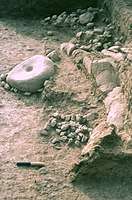Gesher (archaeological site)
Gesher is an archaeological site located on the southern bank of Nahal Tavor, near kibbutz Gesher in the central Jordan Valley of Israel. It bears signs of occupation from two periods, the very early Neolithic and the Middle Bronze Age. The site was first excavated between 1986 and 1987 by Yosef Garfinkel of the Hebrew University of Jerusalem and between 2002 and 2004 by Susan Cohen of Montana State University. The average of 4 radiocarbon dating results suggested inhabitation of the settlement around 8000 BC.[1]
גשר | |
 Shown within Near East  Gesher (archaeological site) (Israel) | |
| Location | 12 kilometres (7.5 mi) South of the Sea of Galilee |
|---|---|
| Region | Jordan Valley |
| Coordinates | 32.602778°N 35.555556°E |
| Type | Tell |
| Part of | Village |
| Area | 18 square metres (190 sq ft) (excavated by Garfinkel) |
| History | |
| Material | Lake bed |
| Founded | c. 8000 BC |
| Abandoned | c. 8000 BC |
| Periods | PPNA, Neolithic |
| Cultures | Khiamian |
| Site notes | |
| Excavation dates | 1986-1987 2002-2004 |
| Archaeologists | Yosef Garfinkel Susan Cohen |
| Condition | Ruins |
| Public access | Yes |
During the Pre-Pottery Neolithic A the site was a small village composed of a few rounded structures. Typical flint finds included a high number of el-Khiam points which Garfinkel argued, along with the relatively early date could class Gesher as a Khiamian site.[1] One outstanding discovery, unknown from any other Neolithic site of the period in the Near East, is a workshop for the production of basalt artifacts. The workshop produced basalt axes and various other tools which were then sent to other early Neolithic centers, such as Jericho and Netiv Hagdud. According to radiometric dates, Gesher is one of the earliest Neolithic sites in the Near East. During this period the first villages were established and the transition to agriculture occurred. A final excavation report on the Neolithic site was published in 2006.
During the Middle Bronze Age IIA, Gesher served as a cemetery. Some 20 graves have been uncovered. These are shaft graves, dug into the local sediment, used for individual burials and never reopened. This facilitates the study of burial customs, including body position, the quantity of grave goods and their relation to the deceased. Bronze spearheads and axes (including three duck-bill axes) were found in four of the graves. A final excavation report on the Middle Bronze cemetery was published in 2007.
 Calibrated Carbon 14 dates for Gesher as of 2013.[2]
Calibrated Carbon 14 dates for Gesher as of 2013.[2] Gesher Pre-Pottery Neolithic A rounded building.
Gesher Pre-Pottery Neolithic A rounded building. Gesher Pre-Pottery Neolithic A flint arrowheads.
Gesher Pre-Pottery Neolithic A flint arrowheads.
Comparative chronology
Bibliography
- Cohen, Susan L. (2004-05-12). "Gesher 2003" (116). Hadashot Arkheologiyot – Excavations and Surveys in Israel. Cite journal requires
|journal=(help) - Cohen, Susan L. (2005-03-24). "Gesher 2004" (117). Hadashot Arkheologiyot – Excavations and Surveys in Israel. Cite journal requires
|journal=(help) - Y. Garfinkel and D. Dag. 2006. Gesher: A Pre-Pottery Neolithic A Site in the Central Jordan Valley, Israel. A Final Report. Berlin: Ex Oriente.
- Y. Garfinkel and S. Cohen. 2007. The Early Middle Bronze Cemetery of Gesher. Final Excavation Report. AASOR 62. Boston: American Schools of Oriental Research.
References
- "Nadel D., Garfinkel Y., The Sultanian Flint Assemblage from Gesher and its Implications for Recognizing Early Neolithic Entities in the Levant, Volume 15, Number 15-2, pp. 139-151". Paléorient. 1989. Retrieved 2011-03-15.
- Shukurov, Anvar; Sarson, Graeme R.; Gangal, Kavita (7 May 2014). "The Near-Eastern Roots of the Neolithic in South Asia". PLOS ONE. 9 (5): Appendix S1. doi:10.1371/journal.pone.0095714. ISSN 1932-6203. PMC 4012948. PMID 24806472.
- Liverani, Mario (2013). The Ancient Near East: History, Society and Economy. Routledge. p. 13, Table 1.1 "Chronology of the Ancient Near East". ISBN 9781134750917.
- Shukurov, Anvar; Sarson, Graeme R.; Gangal, Kavita (7 May 2014). "The Near-Eastern Roots of the Neolithic in South Asia". PLOS ONE. 9 (5): e95714. Bibcode:2014PLoSO...995714G. doi:10.1371/journal.pone.0095714. ISSN 1932-6203. PMC 4012948. PMID 24806472.
- Bar-Yosef, Ofer; Arpin, Trina; Pan, Yan; Cohen, David; Goldberg, Paul; Zhang, Chi; Wu, Xiaohong (29 June 2012). "Early Pottery at 20,000 Years Ago in Xianrendong Cave, China". Science. 336 (6089): 1696–1700. Bibcode:2012Sci...336.1696W. doi:10.1126/science.1218643. ISSN 0036-8075. PMID 22745428.
- Thorpe, I. J. (2003). The Origins of Agriculture in Europe. Routledge. p. 14. ISBN 9781134620104.
- Price, T. Douglas (2000). Europe's First Farmers. Cambridge University Press. p. 3. ISBN 9780521665728.
- Jr, William H. Stiebing; Helft, Susan N. (2017). Ancient Near Eastern History and Culture. Routledge. p. 25. ISBN 9781134880836.